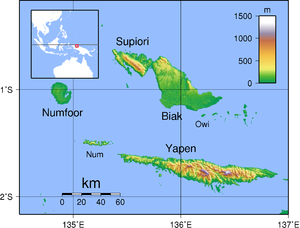Battle of Biak
| Battle of Biak | |||||||
|---|---|---|---|---|---|---|---|
 |
|||||||
|
|||||||
| Belligerents | |||||||
|
|
|
||||||
| Commanders and leaders | |||||||
|
|
|
||||||
| Strength | |||||||
|
Land: 12,000 infantry, 29 artillery pieces, 12 tanks Sea: Task Group 77.2 Attack Group Air: 5 and 13 Air Forces from Nadzab and the Admiralties, A-20s based at Hollandia |
Land: 10,800 infantry, unknown artillery, 9 light tanks Sea: unknown naval forces Air: initially 18 aircraft of 23 Air Flotilla (Ito) at Sorong, 70 fighters and 20 bombers from Japan and the Marianas on 5/28/44, and 20 bombers, 8 reconnaissance aircraft and 48 fighters were redeployed from the Carolines on 5/30/44 |
||||||
| Casualties and losses | |||||||
| 474 killed, 2428 wounded, 3500 casualties due to bush typhus |
~6,100 killed unknown wounded ~450 captured |
||||||
The Battle of Biak was part of the New Guinea campaign of World War II, fought between the United States Army and the Japanese Army from 27 May to 17 August 1944. It was part of General Douglas MacArthur's Southwest Pacific command's offensive drive to clear New Guinea in preparation for an invasion of the Philippines. It was the first major effort by the Japanese to allow uncontested landings for the purpose of creating a kill zone inland.
The island of Biak dominates the entrance to Geelvink Bay, near the western end of New Guinea. The island was held by 11,000 Japanese troops under the command of Colonel Kuzume Naoyuki. Disdainful of the doctrine of defence at the water's edge, he decided instead to allow the Americans to come ashore unopposed so that they would stroll unwarily into the trap he had prepared for them. This would turn the area around the vital airfield there into a martial honeycomb of caves and pillboxes filled with riflemen, automatic weapons, artillery, batteries of mortars, and a single company of nine Type 95 Ha-Go light tanks. Kuzume also stockpiled these positions with enough ammunition, food and water to sustain his defense for months. Water was less than abundant on Biak, where heat and humidity would take a toll equal to enemy gunfire.
It was known from an intercepted message dated 5 May 1944 that the IJA 2nd Area intelligence thought that next Allied landing would probably be on Biak, and a preliminary landing was made on 17 May at Wakde on the way to Biak. There a smaller airfield was available, which could be used as an advanced base until the Biak strips were ready. While initial G2 estimates of enemy troops was approximately 5000, an intercepted message at the end of April gave the ration strength as 10,800, though it was thought this was a figure based upon projected, rather than, current strength.
The 41st Infantry Division (Sunset) of the United States Army landed on Biak on 27 May 1944, initially with the 162nd Infantry Regiment, and soon followed by the remainder of the division. By 5:15 in the afternoon 12,000 troops had landed, with 12 M4 Sherman tanks, 29 field guns, 500 vehicles and 2400 tons of supplies.
...
Wikipedia
